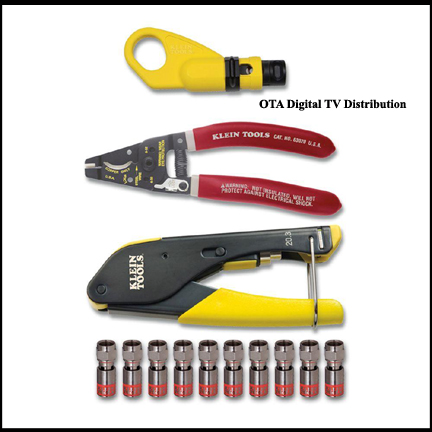
"Over-the Air (OTA) Digital TV Signal Home Distribution"
By Ron Stultz
Summary: Just can not hook a Television (TV) antenna into your home's existing cable cable TV (CATV) coax distribution wiring and expect it to work. Antenna amplifier and amplified splitters required."
Background:
Before doing anything with OTA digital TV, if you live in a rural area and I mean like more than 40 miles from a major city, find one of the several websites on the Internet that will, based on your exact location, provide the true North direction and distance to OTA broadcast stations in some proximity to you. If every station is more than 50 miles away, honestly going to be a struggle for you to ever get "solid" OTA digital TV. When digital TV became a reality number of years ago, those in rural areas with only an antenna were honestly left out in the cold. Ron's rule of thumb here: if station you want OTA is more than 50 miles away you can try but expect TV to freeze or pixilate no matter what you do with antenna, amplifiers, etc. etc.
With cable TV (CATV) being around for almost 40 years now, most homes in America have one or more CATV "drops" or TV connection points in their homes.
With advances in digital media streaming, more and more people are simply choosing to dump traditional CATV and consider a combination of over-the-air (OTA) or free digital TV and various Internet-based media subscriptions.
If you live in a major metropolitan city, simply buying a cheap, window pane mounted antenna, directly connected to a single TV might be all you need.
But how many homes today only have 1 TV? Window pane antenna for each? Each TV gets some channels but not others??
So..why not simply hook an antenna to your existing, no longer used, CATV distribution cabling system??
Somewhere in your home, CATV comes inside from either a buried cable or overhead cable and most likely goes to at least one "splitter" that then splits incoming signal into multiple output coax cables, running to various rooms in your house.
Would be nice to remove CATV coax cable input to splitter and replace with output of a cheap window pane antenna and have free TV everywhere in your home. Would be nice and is possible but just hooking a window pane antenna as input to distribution system splitter is not going to do it.
In Feb 2018, bought a home with 7 coax cable drops across 3 floors but nothing hooked to anything: i.e. no splitters and although COX and Verizon CATV boxes on side of house, neither hooked to anything inside.
Desire was to have one set top box on Cox cable and the rest hooked to new OTA antenna located in attic.
Luckily for me, 1 coax cable from 7 different cables in unfinished portion of basement, went all the way to the attic, where it was split for 2 drops on that floor. With the one coax from attic, was able to install OTA digital antenna and distribute to 7 different locations.
Coax Connectors:
For years have used the cheap, screw-on type coax connectors and suffered the consequences of intermittent bad connections over and over again.
If you are going to do anything serious with OTA digital TV distribution, put money into a crimp coax connector tool.
Example below is a Klien kit sold at many big box stores. Makes stripping coax quick, perfect and easy to get a good connector installed every time.
Seriously should have bought this kit, years and years and years ago.
And "no" I do not sell coax strip and crimp tool kits nor own stock in one, just suggesting based on experience.

Antenna:
OTA digital antennas come in many shapes, sizes and cost. If you are going to actual distribute OTA digital TV signal to more than one TV, do not suggest the flat, window-pane, type.
Before selecting an antenna, search the Internet for a website that, based upon your exact location, will tell you the direction and distance to major OTA broadcast stations.
The further away most OTA stations are from your location, the bigger, better the antenna you going to need.
Outside installation is not required if you have room in an attic and coax there.
Antenna: Air, the space all around you is full of invisible, electromagnetic radiation. Radiation of television and radio stations, cell phone towers, GPS, + +
But all this radiation is weak. You can not simply raise one hand while holding a light bulb in the other and expect to the light bulb to light up.
Same is true with TV antenna. An antenna is designed to snag some of the radiation going past it. The smaller or cheaper design the antenna, the less signal captured.
Antennas are rated by "gain" which some indication of how much invisible radiation it can turn into an electrical signal you can actual use.
The higher the gain, the more signal you have to begin with and thus the antenna is the most important part of any OTA TV distribution system.
The most expensive OTA TV antennas sell for $100 - $150 and worth it.
Whereas the signal provided by a CATV supplier is the volts range, maybe lots of volts, the signal from an antenna is the milivolt range or tenths of a volt or a very, very small volt signal.
Below are images of various OTA high definition (HD) television antennas.
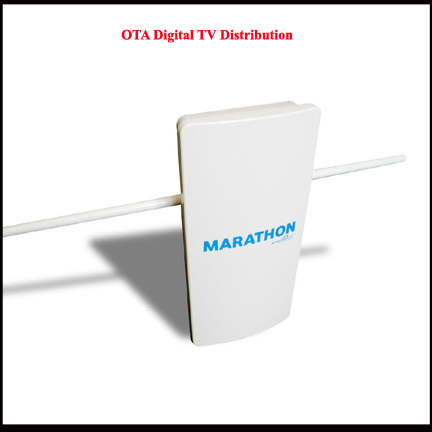
Above is an antenna with amplifier built into it. I have had good luck using this type when OTA stations are with 30 miles.
Similar, to above, amplified antennas to include built-in rotators are sold claiming 100+ mile range. Because of low price and very compact size, suspect real, solid HDTV signal only half of what is claimed, if that.
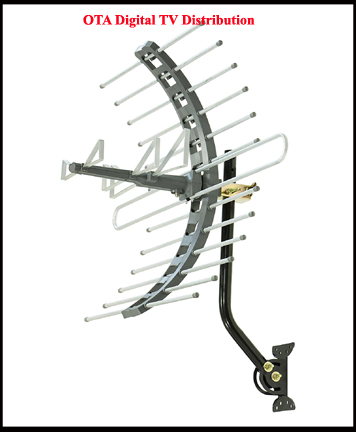
Antenna above is a real HDTV antenna and has been designed to capture HDTV signals. It is directional in that it will not pickup stations it is not generally pointed towards. In my view, this type is significantly better than window pane antenna and most of the antennas with amplifier built into it.
This type of antenna does require an add-on, house powered, signal amplifier right at the antenna.
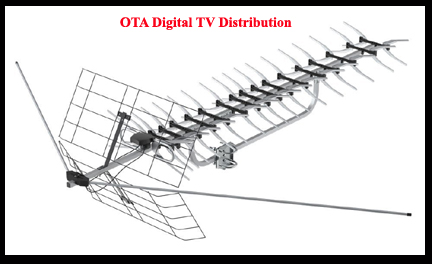
Antenna above is larger version of previous and will provide high quality HDTV signal. This point probably meant for outside mounting but attic install still better if possible.
Again, this type antenna needs a house powered, signal amplifier right at the antenna.
As with most things, experimentation is always in order. Install an antenna without an amplifier first (plan location so easy add if needed) and see what sort of channels and quality of reception you get and then add amplifier, if needed.
Finally, where to locate our antenna. Outside is more of a hassle due to wires having to come inside of house and mounting such that strong winds do not blow antenna off house. If installing in an attic, best to have as far away from electrical noise producers as possible. Electrical noise producers?? Heating, Ventilation and Air Conditioning (HVAC) equipment. If at all possible, do not use same 120VAC circuit that powers your HVAC unit to also power any antenna amplifer you use. Amazing how much electrical junk noise fans put onto house wiring.
Antenna Amplifier:
So at antenna output is milivolts at the antenna BUT to be useful to you, you have to cable it to various locations in your home and no connecting wire is free of resistance or a reduction in the signal it is carrying. Even the best copper wire over any length of cable, reduces the voltage it carries. When the wire is carrying 120V alternating current (AC), like in your house wiring, the drop in voltage due to the wire is not noticeable but in the case of where you have only milivots to begin with, any resistance is bad, so right at the antenna you install, you must install house powered TV signal amplifier.
Yes, house powered. So where ever you mount antenna must have house power via an outlet accessable.
Their are many OTA antenna amplifiers available with some having a fixed gain and some having a variable gain: i.e. fixed "volume" output or variable volume output. Now one would think the way to go would be to get the highest fixed gain output antenna amplifier available and be done with it.
But believe it or not, the digital channel tuner in televisions are not all designed the same way and some pixelate the displayed station if the signal they are getting for that station is too strong!
So suggesting when you buy an antenna amplifier, get one with variable output. Most likely you can set the gain on it to full and be fine, but if you get pixelation of screen freeze on a TV, might improve if you turn down the gain on the antenna amplifier just a little. Experimentation going to be required.
The image below shows a typical OTA digital TV amplifier, installed right at the antenna. Again, must have house power (120VAC) available and coax to rest of antenna distribution system.
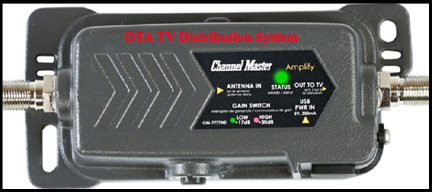
Splitters:
If only going to hook one TV to antenna, don't need a signal splitter as connect coax from antenna amplifier directly into TV.
But want, 2, 4, 6 or even 8 televisions connected to antenna, going to need signal splitter.
NOTE: the most commonly available signal splitters and those normally used in CATV distribution reduce the signal it gets in significantly to each TV attached. Remember, even with antenna amplifier only have very small voltage and thus can not afford to lose any signal at all in distribution system.
Do not use, unpowered signal splitters. Know may already be installed when CATV was installed but do not use or buy and use.
Below shows a common splitter sold everywhere and used in CATV distribution systems.
Note, clearly marked on each output is that "Out" is -4.5dB. Will not explain dB but (-) means reduction in signal. Nope, nope, nope.
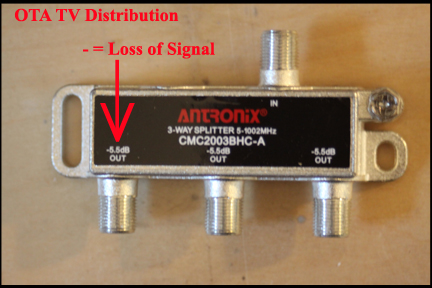
Below is an 8 port, house 120VAC powered, amplified "splitter", which unlike the one above, does not reduce the input signal sent on to various attached TV's but actually amplifies each cable drop. Although hard to read, each of the 8 outputs show +4.5dB signal out.
Amplified signal splitters or distribution amplifiers come in various port sizes from 2 to 8. Again, point being, if you have to split an antenna based HDTV signal, only use house powered distribution amplifiers.
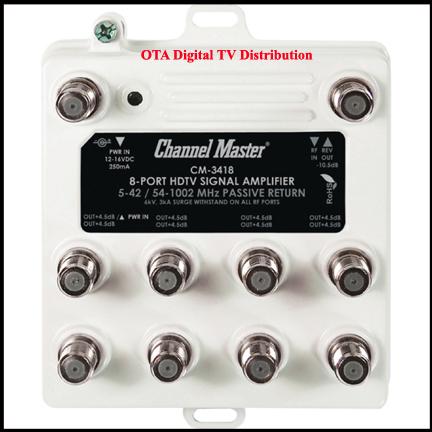
Splitter Terminators:
Often overlooked is the need to "terminate" all unused HDTV ports with a 73 ohm terminator. Will not detail why this is required other than to say, with open port, say in a room with no TV attached or at splitter with no coax cable attached, the signal from the antenna will tend to reflect or "bounce" back up the cable and interfere with the signal you really want at each of your antenna connected televisions.
Coax terminators are usually sold in a small quantity and are readily available at big box retailers. Some are gold plated but in the end, such a simple device, really does not matter how much they cost. Just use them on every cable drop (connector) in room with no TV or on splitters with no coax cable connected to a port.
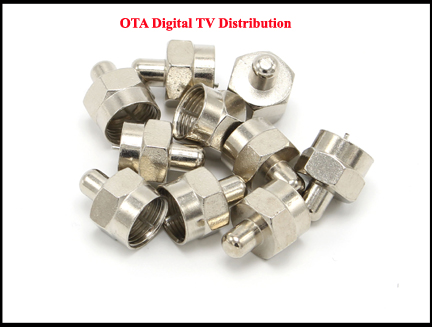
System:
Ok, so now have defined all components of an over-the-air (OTA) high definition (HD) television (TV) distribution system.
In summary: Good antenna in attic or outside of house pointing in direction of most OTA broadcast stations, connected to a house powered signal amplifier that then runs via coax to a house powered splitter or distribution amplifier which then feeds as many televisions has you have in your house located near a cable drop.
Finally, it is possible that the only way you can get your antenna connected to every TV in your house is to send an amplified signal from a splitter to another splitter that then splits the signal again, and so on. This is never optimal but rewiring is often like this. If you must do this, make sure you use amplified splitters or distribution amplifiers at each split. Again, experiment first. If all TV's are getting channels desired and not freezing or pixilating, then no amplified splitter is required.